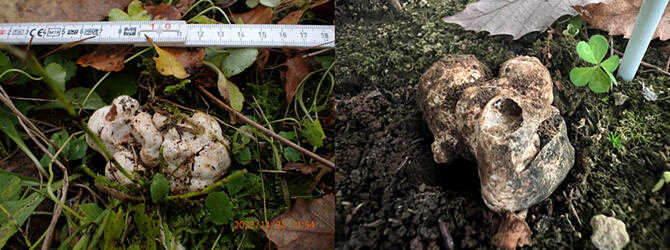A research group led by Takashi Yamanaka, head of the Tohoku Branch of the Forestry and Forest Products Research Institute, and Noritaka Nakamura, a researcher at the research institute's Kyushu Branch, announced on February 9 that they had succeeded for the first time in artificially cultivating the Tuber japonicum white truffle. After planting Quercus serrata saplings inoculated with the fungus at test sites in Ibaraki and Kyoto prefectures, the seedlings developed fruiting bodies. Morphological and genetic analysis confirmed that these were artificially inoculated white truffle seedlings. The results are expected to lead to the practical application of artificial cultivation of white truffles.

Provided by Forestry and Forest Products Research Institute
Truffles are a premium mushroom in western cuisine, with Italy, Spain and France being the most famous growing regions. Demand has increased in Japan in recent years, but all truffles in circulation are from overseas and imports are on the rise. European imports cost around 90,000 yen per kilogram and are traded at a higher price than domestic matsutake mushrooms.
Truffles are the fruiting bodies of mycorrhizal fungi that grow symbiotically on the roots of living trees and form in the soil near the ground. Matsutake mushrooms are the most common mycorrhizal mushrooms.
Wild truffles exist in Japan and have a flavor similar to that of truffles from abroad. Cultivating the truffles could mean a stable supply of safe and secure domestic truffles, which could lead to the creation of a new industry.
Against this background, the institute launched a project in 2015 to cultivate domestic truffles. The white truffle, Tuber japonicum, and the black truffle, Tuber himalayense, have been selected for cultivation as the research continues. Tuber japonicum is said to have a mellow, garlicky aroma, similar to white truffles from Europe and the United States, but is thought to be endemic to Japan.
Research and investigation of the ecology and culture characteristics of the truffles were unknown at the start of the study. The study revealed, among other things, that mycorrhizae form on Quercus serrata and pine. Studies in parts of Europe and in the United States, where cultivation has been successful, have used the method of growing saplings by planting fungus‐inoculated seedlings like in an orchard.
In February 2017, a mycelial and spore mixture of Tuber japonicum was inoculated into Quercus serrata seedlings to produce saplings for planting. In August of the same year, mycorrhizal formation was confirmed, and these mycorrhizal‐forming saplings were mixed with uninoculated saplings to increase production for planting.
The saplings were planted in sites in Ibaraki Prefecture in October of the same year, and were regularly examined for the formation of mycorrhizal fungi based on morphological characteristics and genetic information and establishment of the fungi was confirmed in October 2018. In April 2019, the planting sites were expanded to other sites in Ibaraki, Kyoto and Nara prefectures for a total of four sites, where they managed and confirmed the establishment of the fungus. During the cultivation period, they suffered from the development of other mycorrhizal fungi and from damage from wildlife feeding.
As a result, a total of two planting sites, one in Ibaraki Prefecture and one in Kyoto Prefecture, were confirmed to have produced eight and 14 fruiting bodies respectively in November 2022. There was reportedly one piece of about 9 cm weighing 60 g, and three pieces of about 7 cm, which is large enough to be used in food. However, there were 22 other smaller truffles, weighing a total of 226 grams.
After recording the location from where they were collected, morphological observations and species identification work based on the sequence of the ITS region of the ribosomal DNA confirmed that the species was Tuber japonicum. Genetic identification using SSR markers further confirmed that the fruiting bodies were from a strain inoculated on the saplings.
"In this research, truffles grew in as little as three years and seven months after the saplings were planted," said Yamanaka. "We would like to investigate this trend as we expect it to continue to occur in subsequent years. Meanwhile, we will continue to investigate whether the truffles are cultivated at the test sites where no growth occurred this time. Through these investigations, we hope to identify the suitable conditions and factors for their growth. We would like to conduct further planting trials on a scaled‐up basis and evaluate the labor input and cost calculations, with the aim of making the cultivation technology practical."
This article has been translated by JST with permission from The Science News Ltd. (https://sci-news.co.jp/). Unauthorized reproduction of the article and photographs is prohibited.




